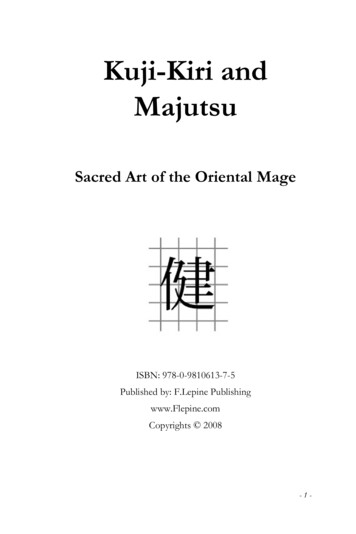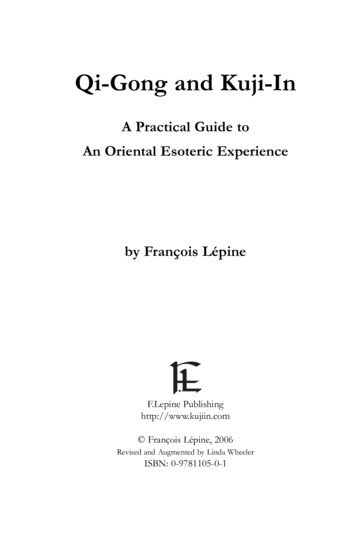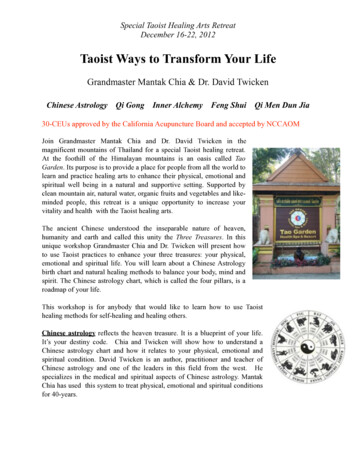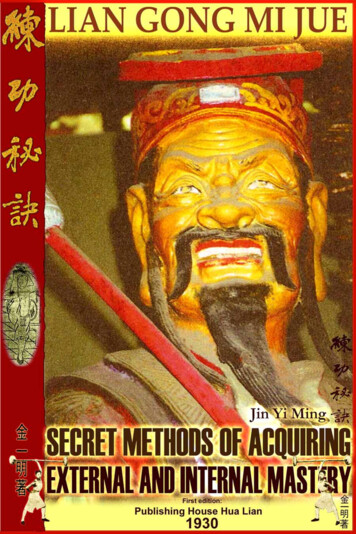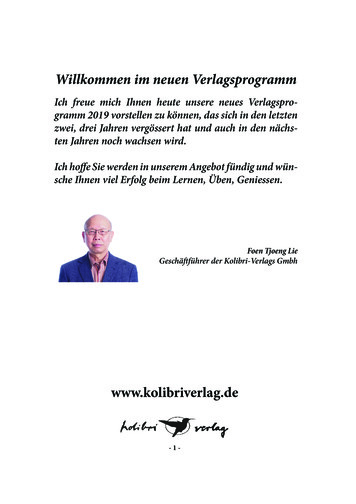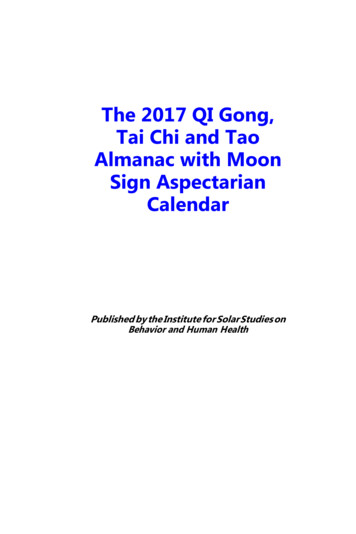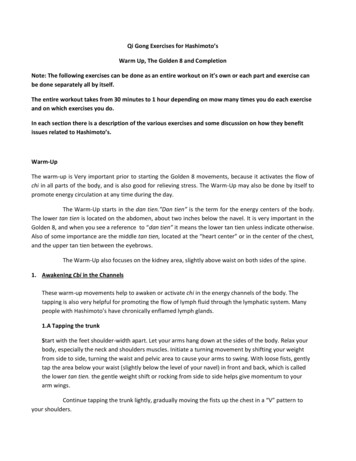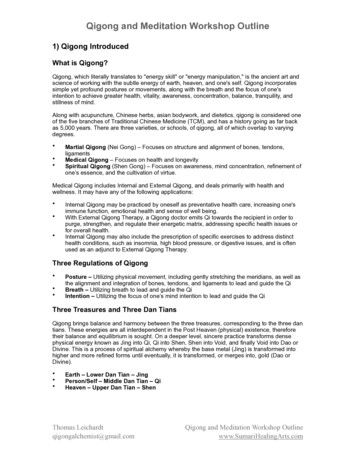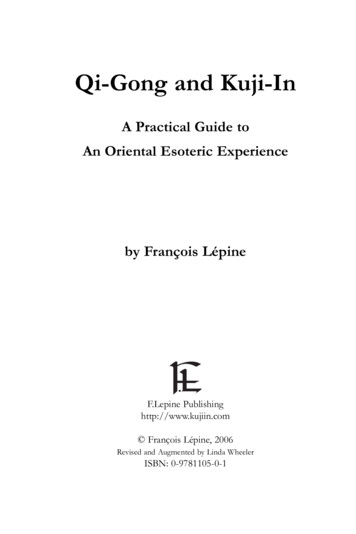
Transcription
Qi-Gong and Kuji-InA Practical Guide toAn Oriental Esoteric Experienceby François LépineF.Lepine Publishinghttp://www.kujiin.com François Lépine, 2006Revised and Augmented by Linda WheelerISBN: 0-9781105-0-1
I thank the Masters that havetaught me this Sacred knowledge.I pray that you may have a blessed experienceas you practice the powerful techniques found in this book.- François Lépine
Table of ContentsIntroduction . . . . . . . . . . . . . . . . . . . . . . . . . . . . . . . . . . . . . . . . . .7Summarized Theory . . . . . . . . . . . . . . . . . . . . . . . . . . . . . . . . . .11Oriental Energy Systems: Jin, Qi, Shen . . . . . . . . . . . . . . .13Jin . . . . . . . . . . . . . . . . . . . . . . . . . . . . . . . . . . . . . . . . . . .14Qi . . . . . . . . . . . . . . . . . . . . . . . . . . . . . . . . . . . . . . . . . . .15Shen . . . . . . . . . . . . . . . . . . . . . . . . . . . . . . . . . . . . . . . . .16Chakras . . . . . . . . . . . . . . . . . . . . . . . . . . . . . . . . . . . . . . . .17Techniques . . . . . . . . . . . . . . . . . . . . . . . . . . . . . . . . . . . . . . . . . .19The Physical Body . . . . . . . . . . . . . . . . . . . . . . . . . . . . . . . . . .20Breathing . . . . . . . . . . . . . . . . . . . . . . . . . . . . . . . . . . . . . . .20Normal and Reversed Breathing . . . . . . . . . . . . . . . . . .20Radial Qi Gathering method . . . . . . . . . . . . . . . . . . . . .25Feeling the Flow of Qi . . . . . . . . . . . . . . . . . . . . . . . . . .30Qi-Gong . . . . . . . . . . . . . . . . . . . . . . . . . . . . . . . . . . . . . . . .33Small and Grand Circulation . . . . . . . . . . . . . . . . . . . . .33Dance of the Dragon . . . . . . . . . . . . . . . . . . . . . . . . . . .36The Elixir of Life . . . . . . . . . . . . . . . . . . . . . . . . . . . . . .44
Of the Heart . . . . . . . . . . . . . . . . . . . . . . . . . . . . . . . . . . . . . .47The Mantra of Compassion . . . . . . . . . . . . . . . . . . . . . . . .47Implication . . . . . . . . . . . . . . . . . . . . . . . . . . . . . . . . . . . . . .49Karma and Dharma . . . . . . . . . . . . . . . . . . . . . . . . . . . . . .52Lessons of the Mind . . . . . . . . . . . . . . . . . . . . . . . . . . . . . . . .55Meditation . . . . . . . . . . . . . . . . . . . . . . . . . . . . . . . . . . . . . .55The Green Dragon at the White Gate . . . . . . . . . . . . .55Hands of the Spirit . . . . . . . . . . . . . . . . . . . . . . . . . . . . . . .58Basic Hand Mudras . . . . . . . . . . . . . . . . . . . . . . . . . . . . .58Elemental Mudras . . . . . . . . . . . . . . . . . . . . . . . . . . . . . .64Kuji Goshin Ho . . . . . . . . . . . . . . . . . . . . . . . . . . . . . . . . . . . . . .73Kuji-In Techniques . . . . . . . . . . . . . . . . . . . . . . . . . . . . . . .75Kuji-In Additional Information . . . . . . . . . . . . . . . . . . . . .97Complete Kuji-In Ritual Practices . . . . . . . . . . . . . . . . . .99Kuji-In Philosophy . . . . . . . . . . . . . . . . . . . . . . . . . . . . . .102Conclusion: No mind . . . . . . . . . . . . . . . . . . . . . . . . . . . . . . . .113
IntroductionThe human body, despite the fact that we use it every day of ourlives from birth to death, is still the center of many profoundmysteries. The mysteries of the heart and mind (which seem todefy the ability of science to dissect and understand) are evengreater. By comparison, the mysteries of the Spirit are beyondthe reaches of our imagination. For this reason, we begin our spiritual work with the study and practices that use the human bodyas a tool. Through our personal research, we will find many spiritual secrets are hidden in the workings of our physical and tangible experience.We could write an entire book for each chapter we have writtenhere. However, we wish to concentrate on the practical aspects ofeach of the techniques we will be showing you. Thus, we willsummarize a great deal of information in but a few lines. Thereare also a few technical words that you may want to understandbefore you start learning about this mystical art. These words areessential to your understanding of the rest of the book, and wewill repeat their names often to make their assimilation easier.These new terms are in bold below, followed by an explanation oftheir meaning and use.Meridians: There are many circuits of energy in the human body.Most of them start or end at an extremity such as the fingers ortoes. The Chinese refer to these energy circuits as Meridians. BothQi-Gong and Kuji-In employ certain tools to stimulate and direct-7-
the energy emanating from these energy circuits in order to healyour body on the energetic and physical levels and to help youmanifest your desires. The techniques you will use to work withenergy include: breathing exercises, visualizations (calledmandalas), chants/prayers (called mantras) and hand positions(called mudras). Qi-Gong and Kuji-In use these mandalas,mantras and mudras, along with specific exercises, to help youconnect with your Higher Self. This book also provides theconceptual context that will make it possible for you to successfully use these techniques.Mudra: A “mudra” is a hand gesture or a hand position that isemployed to bring into effect the flow of energies that terminateor start at the fingertips.Mantra: The energy of the body can also be stimulated throughsound. A “mantra” is a sound, which can take the form of eithera short word or a more complex prayer. A mantra will stimulatespecific energy patterns within and around you.Mandala: Above all, the symbols and imageries in your mindaffect the flow and the manifestations of the energies you use. A“mandala” is a symbol or image that is visualized in order toengage the mind in active participation with an energy work or aspiritual process.Mudra, mantra and mandala: these are three simple tools that canenhance your entire spiritual experience. These tools affect theenergies in your physical and spiritual body. When combined, theycan greatly enhance your personal development. They can-8-
produce any kind of effect, from accelerating the healing of thebody to aiding you in developing psychic abilities. These tools area part of a sacred knowledge called Qi-Gong, which means“working with energy” or “energy practice”.There is another art called “Kuji-In” that redefines your vision ofthe world around you. Practicing its techniques will slowly revealto you a vision of the universe that you could not haveanticipated before you began, because it allows your limitedhuman mind to expand its vision, to perceive the Source of All.This spiritual method will surely help you progress on your pathto the realization of your full potential. Here follows a Buddhistcontemplation that I hope will inspire you about the state of mindthat the Kuji-In intends to develop in each practitioner.Buddha said: “I consider the positions of Kings and Rulersas that of dust motes. I observe treasures of gold and gemsas so many bricks and pebbles. I look upon the finest silkenrobes as tattered rags. I see myriad worlds of the universe assmall seeds of fruit, and the greatest lake in India as a dropof oil on my foot. I perceive the teachings of the world tobe the illusion of magicians. I discern the highest conception of emancipation as a golden brocade in a dream, and Iview the holy path of the illuminated ones as flowersappearing in one’s eyes. I see meditation as a pillar of amountain, Nirvana as a nightmare of daytime. I look uponthe judgment of right and wrong as the serpentine Dance ofa dragon, and the rise and fall of beliefs as but traces left bythe four seasons.”Above all, let the knowledge of this book be assimilated throughexperience rather than isolated intellectual analysis. Take the timeto contemplate the feeling each technique evokes for you. Pay-9-
attention to your body, your heart and your mind. Eventually, youwill become aware of your Spirit. All of the technical words willbe surrounded by practical instructions, and this will help yourmind make the necessary links. Trust yourself and have a goodlearning experience.- 10 -
Summarized TheoryThe Buddhist, Taoist and Hindu teachings contain the fundamental wisdom that can be found behind most Oriental practices. Allthe teachings of the mantra’s sounds, the mudras gestures and themandala’s symbols come from these sources, as well as from themany applications of meditation those teachings utilize. Chinesemedicine is also a very important source of knowledge forQi-Gong practitioners.The martial arts that were developed by the Shao-Lin monks usea mystical secret science to control the energy in the body. Thisprofound science is called Qi-Gong. Qi is energy in its manifestedform, and Gong is the practical method of application. Therefore,Qi-Gong methods are the means or techniques of controlling theflow of energy inside your body. After a while, with a lot of practice, you can also experiment with the manifestation of Qi outsideyour body.The most popular form of Qi-Gong in North America andEurope is Tai Qi Chuan. The art of Qi-Gong existed long beforethe martial artists incorporated it in their fighting styles. Therefore,there are a lot of Qi-Gong practices that are very easy on the body.These practices are not linked with any specific fightingtechniques, and it is not necessary to learn to fight to learn thesetechniques.- 11 -
Like many esoteric philosophies, the Buddhists teach that, in orderto attain spiritual illumination, one must undertake the necessaryexercises with a sincere heart. The secrets of healing, the abilityto see beyond ordinary reality, the gift of communication frommind to mind, these are all aspects of the Buddhist’s magical system. Like every group of Alchemists, they also seek to expandtheir lifespan beyond the normal period. Yet none of theseabilities will manifest for you unless you begin with the properattitude.The Qi-Gong techniques shown in the first lessons are the basicmethods which will enhance your ability to experience spiritualenergies. After you have achieved the ability to sense energy, wewill concentrate on the practical aspects of the oriental esotericscience of Kuji-In. We encourage you to learn more aboutChinese Medicine and the channels of energy in the body. It is alsovery important for you to choose a meditation technique and tomeditate frequently if you want to benefit from the enormouspotential of the methods explained in this manual. For beginners,a simple meditation technique is provided in this book. As youlearn more and as you diligently practice what you have learned,your experiences with Qi-Gong and Kuji-In will improve.- 12 -
Oriental Energy Systems: Jin, Qi, ShenIn the last section we explained that energy takes shape in a broadrange of manifestations: light, movement, electricity, life. Thuswe find that energy will manifest in your body in many ways. Wehave classified them here as three types of energy: Jin, Qi andShen. These are the energies that flow in the physical body according to Traditional Chinese Medicine. They take other names inoccidental occult philosophy, and we will speak about these otherterminologies elsewhere.JinThe energy that directly influences the physical plane is called Jin.It is the power that is converted into physical movement; it is heatenergy, and it is the force behind every action. Jin can be converted from Qi, which is a more subtle energy. Many methods for converting Qi into Jin involve compressing Qi until it is dense enoughto become available on the physical plane, where it can manifest.Jin can produce heat, it can create more intense electric currents inour nervous system, it can heal our body more quickly than Qialone and it can augment physical strength. Jin is energy acting ongross matter. It usually flows through the lower abdomen.You will develop the Jin level of energy through the use ofbreathing exercises and Qi-Gong practices. Jin will be used inmany of the physical practices you will be learning in the nextseveral sections. Jin assists us in developing willpower andself-confidence. Willpower and self confidence help the Jin tomanifest physically.- 13 -
QiQi is energy in its ethereal form. It is our life force. It is bioelectricity. It is naturally used by the body for all of our life functionsand it is used by the brain to operate. Qi can move from one placeto another before it is converted to the active form of Jin or to theelevated form of energy known as Shen. We wish to develop andaccumulate Qi because it is easy to use and because it offers us thewidest range of applications. Breathing techniques enhancethe movement of Qi in the body, as well as our ability to makeeffective use of mental imagery.The more freely Qi can move in and around your body, the healthier you will be, and the more clearly you will be able to think.Qi can be stored inside the body battery for later use (more on thisin other chapters). Qi can move through the body and, withexperience, outside the body. It can be transferred to someone elsefor healing purposes, or for the exchange of Qi to another person.Great Chinese doctors use it in all sorts of medical techniques.Martial artists use it to augment their power and speed. It is alsospelled Chi in the case of Chi-Gong, or Ki. The Chinese andJapanese characters are not alphabetical; they are pictograms, sotheir spelling in English varies.- 14 -
ShenShen is the spiritual aspect of energy. It is more volatile and harder to feel. It is always present, but the average person won’t evenknow it is there. It is the energy used in internal spiritual methodslike prayer and meditation. As we develop Shen, we also developour Spirit and elevate our consciousness. Little information aboutShen is available to the average person. In fact, a practitioner onlybecomes aware of its existence after extended training.- 15 -
ChakrasWe will be very brief regarding the definition of the “Chakras”.The topic of Chakras is a subject too vast to cover in detail in thisbook, but we will give you the basic information needed to use thedifferent techniques shown here.The Chakras are the main energy centers found in the physicalbody. Each Chakra has specific primary functions you will need toknow. These will be described along with the techniques that activate those functions. There are seven major Chakras.1- Base Chakra: Located at the base of the spine; extends from thebase of the pelvis at the front of your body, to the coccyx at theback of your body. The base Chakra thus covers the entire base ofyour body.2- Navel Chakra: Located about one inch below your navel.3- Solar Plexus Chakra: Located at the solar plexus, right underyour sternum.4- Heart Chakra: Located directly in the middle of the sternum, infront of your heart.5- Throat Chakra: Located in the little indentation of bones at thebase of your throat.- 16 -
6- Third Eye Chakra: Located between your eyebrows.7- Crown Chakra: found at the top of your head, with the centerpoint exactly on top of your head, but spreading down to surround part of your head, around the forehead and the back of theskull.Another important Chakra is called the “Jade Gate”, and it isfound at the back of the head, on the pointy bone at the back ofthe skull.Behind the Navel Chakra, in the middle of the body, inside thelower abdomen, is a place which is called the “Dan-tian” inChinese Medicine; we will refer to it in our practices. It is in theDan-tian where the energy of the body is gathered and stored forlater use.It is not necessary to remember all these Chakras right now. Wewill give you the information you need about the Chakras throughout the book.- 17 -
- 18 -
TechniquesAs you start training, we encourage you to eat well and exercisesregularly to keep your body in good health. Some of thetechniques you will be learning are more demanding than others.Respect your limits, while always trying to go beyond them safely.Since some of these techniques might raise your body temperatureaggressively, we encourage you to drink a lot of water.It is good to experiment with all of the techniques at least once,until you discover which ones you prefer. Once you decide whatworks best for you, feel free to spend more time on the practicesyou prefer. Follow your heart and do not doubt yourself. Youshould use at least one physical practice, one heart practice, onepractice for the mind and one for the Spirit. The first subtle resultswill come quickly, then a longer period of time might pass beforeyou see any tangible results. During this plateau period, your bodywill be accumulating and increasing your energy level. Do notbegin your training by focusing on the end-results you may eventually attain; instead, enjoy the immediate benefits that these exercises provide. Before all else, seek Love. The power associatedwith these practices will come by itself. If you seek power, it willtake much more time for the effects to manifest, and they will notbe as impressive.- 19 -
The Physical BodyBreathingNormal and Reversed BreathingNormal Breathing:Normal Breathing is very different from the automatic breathingcycle that keeps you alive when you are not thinking about breathing. The reason is simple: no one really breathes correctly withoutthinking about it. Most people take in only 11 ml of oxygen perminute, far below the minimum oxygen your body needs to behealthy. A Normal Breath is a healthy breath.An inhalation should fill your lungs almost completely withoutstraining your abdomen or diaphragm. The breath should naturally fill your abdomen, without raising your upper torso. A deepbreath should not even make your upper ribs move. Place yourhand over your heart, where your ribs connect to your sternum,between your solar plexus and your throat. Take a deep breath andfeel to see if your ribs are moving. If they do, you are filling yourupper lungs too much, and not enough air is getting to the bottomof your lungs. Although it is impossible to keep your rib cagetotally immobile (which is not the objective) it should move as little as possible without requiring too much effort.When you exhale, let your abdomen rest until the air doesn’t comeout naturally anymore, and then pull your abdomen in slightlywithout force. It won’t completely empty your lungs. If your ribs- 20 -
are moving inward or downward too much, it means you had tolift them upward when you inhaled, or that you filled the upperpart of your lungs too much.Breath inAbdomen outUpper chest normalBreath outAbdomen normalUpper chest normalWhen you breathe normally, it is your abdomen that pushes outslightly and pulls in slightly, (as you inhale and exhale). The breathing cycle should not require excessive force, but it should fill yourlungs up to 80% of your maximum capacity. To fill your lungs to100% of their capacity requires effort, and it is not natural.Breathing out with force and pulling in your abdomen slightly atthe end of the breath empties your lungs to 10% or 20% of theircapacity. Just as it is not healthy to fill your lungs to 100%, it is nothealthy to empty them completely; to empty your lungs totallyrequires the application of more force than to bring them to anatural state.- 21 -
To learn this for yourself, try filling your lungs completely (without hurting yourself), while keeping your rib cage as immobile aspossible. Then, hold the air in for 10 seconds and breathe outcompletely, holding your breath out for 10 seconds. Let all yourmuscles relax and allow your body to breathe without influencingit, while you think about the difference between these two ways ofbreathing. Now, take in a Normal Breath, filling your lungs downto your abdomen with only a slight effort. Hold the air in for3 seconds, and then let it out without any other effort than a slightpulling inward of your abdomen at the end of exhalation.This is what is meant by a “Normal Breath”. Normal Breathingwill be used in all of the techniques that focus on the elevation ofself, such as meditation, mental and spiritual training. TheReversed Breath is used in physical development, to open thechannels of energy in your body and to enhance your ability tomanifest your Qi on the physical plane.Reversed BreathingTo clearly understand the principles of Reversed Breathing, youmust first practice accurate Normal Breathing. It is important tokeep your rib cage almost motionless while doing the ReversedBreathing. You should also understand the principles of Jin, Qiand Shen in order for this practice to be effective.The Reversed Breathing cycle is used to concentrate or compressyour Qi in a way that will make it denser, compressing it, so it canbecome available on the physical plane. It is used to produce Jin- 22 -
from your Qi. When you compact the Qi, you will feel heat. Thisis the Jin.To clarify this for you, forget about the Normal Breathing methodfor a moment and let yourself breathe instinctively. Imagineyourself in a situation where you are very alert, perhaps needing todefend yourself, thus requiring that you are ready for immediateaction. While closing your fists, take in a quick, deep breathwithout thinking. Most people will notice that the abdomenautomatically pulls in when you are breathing in, and it pushes outslightly when you exhale. Experiment a bit with this breathing.When in Danger, the body automatically does a Reversed Breath,getting ready to pour energy into physical action. The quick breathmentioned above was only meant as an example. For the ReversedBreath method, the breath should be drawn in as smoothly as theNormal Breath unless stated otherwise.Breath inAbdomen pulled inUpper chest normalBreath outAbdomen let outUpper chest normal- 23 -
When we are working with methods that focus on manifestingphysical phenomena, we will be doing Reversed Breathing. Theupper rib cage still doesn’t move, and you should still breatheslowly and comfortably. As you breathe in, contract yourabdomen, pulling it in slightly. As you breathe out, release yourabdominal muscles completely, pushing out slightly at the end ofthe exhalation, without force.- 24 -
Radial Qi Gathering methodBefore you do anything that utilizes Qi, you must have Qi reservesto work with. Working without reserves of Qi will deplete yourown life force, which should be avoided at all cost. Gathering Qiis quite simple, and you can do it just about anywhere and anytimeas long as you aren’t doing something that requires concentration.For example, don’t do this when you’re in a moving car. When yougather Qi, you and everyone around you will get a little bit moreprone to lose their concentration. For example, everyone could getsleepy, or hyper, or feel strange sensations in their body, especially if they are not used to feeling Qi. Moreover, you will need to beable to use your concentration for the visualizations that arenecessary to successfully gather, store, and move Qi. The energythat you envision is real and it will follow your concentration. Asyou visualize it traveling with your breath down to the area belowyour navel, the Qi will be moved to your Dan-tian. When youvisualize compressing it in your Dan-tian, this too will actuallyoccur. You may use the pictures as a guide, and you will find ituseful to think of the energy you are moving as a white cloudwhich flows like a stream wherever you direct it with your mind.- 25 -
Storing Qi in your Dan-tianPlace your palms on your Dan-tian, whichis just below your navel (fig. 1). Menshould have their left palm inside, touching their Dan-tian, with their right palmover their left. Women should have theirright palm inside, with their left palm overtheir right. If you are standing, bend yourknees slightly. If you are sitting, try tokeep your spine straight, and do not crossyour legs.As you inhale, visualize white lightcoming from all around you, penetratingall the pores of your skin, flowing intoFig.1your body and filling your inner Dan-tian.Remember that what you visualize is actually occurring. As youexhale, all of this white energy is condensed into a concentratedball of light in your inner Dan-tian, in the middle of yourbody just below the level of your navel. Gather Qi by breathingnormally, deeply, and calmly. Take in Qi from all around you andconcentrate it in your inner Dan-tian.- 26 -
Active GatheringStand up, take a few Normal Breaths and relax. Slightly bend yourknees and begin.As you breathe in, imagine a white light coming from above you,which enters through the top of your head rather like a whitewind, descending in a continuous flow to your Dan-tian. Pleaserefer to fig. 2 below. You may use this figure as guide for yourvisualizations. As you breathe out, the energy remains in yourlower abdomen and becomes a ball of light. Take nine relaxedbreaths, absorbing Qi (the white light) from the area above yourhead. You may find that you tighten the muscles of your abdomenand arms when you try this for the first time. That is a normalreflex. Practice using just your will to draw the energy down, whilekeeping your muscles relaxed.Fig.2- 27 -
In the next exercise, you will draw energy into both hands, throughthe trunk of your body, and down into the Dan tian. You willinhale, and draw energy in through both hands simultaneously. Todo this, extend your arms out to your sides, with your palms facing away from you; absorb the energy through the middle of yourpalms, drawing the energy through your arms, the trunk of yourbody, and down into your Dan-tian. Repeat this sequence, (inhaleand draw the energy down to the Dan-tian) nine times. Relax yourbody and make this entire process as effortless as possible.Next you will repeat this process with both of your feet, drawingthe wind-like energy up into the soles of your feet, and upFig.3- 28 -
through your legs, directing the flow to your Dan-tian. When youhave the energy centered in your Dan-tian, visualize the whiteenergy ball growing stronger and stronger with each of the ninebreaths.Once you’ve taken nine breaths, while drawing the energy intoyour Dan-tian through each of the 5 centers, (filling yourabdomen from the area above your head, and from both of yourhands and feet), you will proceed to draw energy through all 5centers at the same time, using all five entry points simultaneously, and filling your Dan-tian with nine breaths of energy. (fig. 3)Finish this exercise by placing your palms over your Dan-tian andtaking a few Normal Breaths. This will help to store the energyyou have gathered.- 29 -
Feeling the Flow of QiWhile your body is taking in oxygen and circulating it, it is alsonaturally circulating bioelectric energy. This energy is used tomanage bodily functions and to sustain life. The calmer and moresmoothly this energy flows, the healthier we are and the moreclearly we think. Our emotions are influenced by this bioelectricenergy flow as well as by our hormones.In the same way that we have learned to draw energy into theDan-tian by concentrating on our breathing and visualizing thebioelectric energy as it follows our breath into our Solar Plexus, wecan also concentrate on our breathing and direct the bioelectricityin other ways. For example, we can make this energy flow throughour body simply by desiring it to do so. When we wish to lift anarm, we don’t need to know how the blood flows in the veins andhow the neural energy stimulates the ADP of the muscle fibers tomake them contract all we need to do is “will it” and the armlifts. A baby can lift its arm as well as a scientist. It only has to desireto do so.In order to cause this to occur according to your desires, yousimply need to imagine where the energy is and where you want itto go, and the Qi will behave accordingly, following the motion ofyour mental image. With time and practice, you will be able to feelthis movement of Qi as if it was a wind flowing through your body.Some people describe this as a feeling that water is flowing fromthe source of the Qi to wherever they direct it. The traditionalname for the art of causing this energy to flow in accordance withyour desires is Qi-Gong, meaning “the practice of Qi.”- 30 -
Breathing will enhance the movement of Qi. Visualization alonewill also cause Qi to flow, but not enough to make your practicetruly efficient. In order for this practice to be truly effective, youmust breathe properly, mentally visualizing the flow, then you mustdesire that the bioelectric energy move to the specified location.This is similar to wanting to move your arm; you desire it and itoccurs, even though the rest of your body remains motionless. Itis an isolated action, affecting only that part of you that you desireto move. Breathing normally is essential to the development ofyour energy channels and to the use of Qi in its many applications.When you breathe in, you are drawing energy into you, and whenyou breathe out, that energy will flow to wherever you direct it.Clear visualizations, proper breathing and the proper use of desireare crucial to effective movement of the Qi.It is important that you follow the basic training process outlinedhere so you can correctly train your mind to visualize the goodenergy moving according to your desires. We strongly recommendthat you never imagine any chaotic or disordered energy movingthrough your body, because it might disturb your regular bodilyfunctions.A step by step approach is necessary to develop your mentalability to control Qi in your body. As you acquire the necessaryknowledge and experience in the art of directing this energy flow,you will be able to feel the effect of your training and understandthe different applications of Qi-Gong more quickly and morecompletely.- 31 -
Technique for Learning to Sense Qi:Once you’ve practiced the Gathering Qi method, your body has alittle more Qi than it normally does, and this makes it easier foryou to feel the Qi. Never do any Qi exercises without filling y
Qi-Gong practitioners. The martial arts that were developed by the Shao-Lin monks use a mystical secret science to control the energy in the body. This profound science is called Qi-Gong. Qi is energy in its manifested form, and Gong is the pr actical method of application. Therefore, Qi-Gong methods are the means or techniques of controlling the
